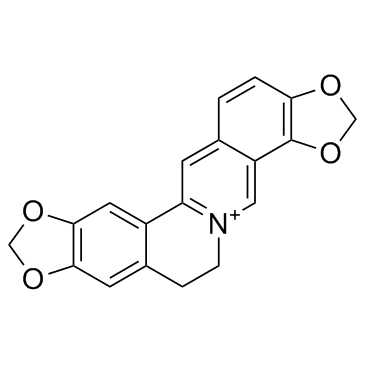
Coptisine
CAS No. 3486-66-6
Coptisine( Coptisin )
Catalog No. M18462 CAS No. 3486-66-6
Coptisine treatment increases cell viability based on its reversal effect on the enhanced activity of Indoleamine 2, 3-dioxygenase.
Purity : >98% (HPLC)
 COA
COA
 Datasheet
Datasheet
 HNMR
HNMR
 HPLC
HPLC
 MSDS
MSDS
 Handing Instructions
Handing Instructions
| Size | Price / USD | Stock | Quantity |
| 5MG | 74 | In Stock |


|
| 10MG | 125 | In Stock |


|
| 25MG | 237 | In Stock |


|
| 50MG | 428 | In Stock |


|
| 100MG | 627 | In Stock |


|
| 200MG | Get Quote | In Stock |


|
| 500MG | Get Quote | In Stock |


|
| 1G | Get Quote | In Stock |


|
Biological Information
-
Product NameCoptisine
-
NoteResearch use only, not for human use.
-
Brief DescriptionCoptisine treatment increases cell viability based on its reversal effect on the enhanced activity of Indoleamine 2, 3-dioxygenase.
-
DescriptionCoptisine treatment increases cell viability based on its reversal effect on the enhanced activity of Indoleamine 2, 3-dioxygenase . Coptisine treats myocardial I/R likely through suppressing myocardial apoptosis and inflammation by inhibiting the Rho/ROCK pathway. Coptisine is a potential anti-osteosarcoma drug candidate, via exerting a strong anti-osteosarcoma effect with very low toxicity .Coptisine with a high dosage could inhibit cholesterol synthesis via suppressing the HMGCR expression and promoting the use and excretion of cholesterol via up-regulating LDLR and CYP7A1 expression. Coptisine suppresses adhesion, migration and invasion of MDA-MB-231 breast cancer cells in vitro, the down-regulation of MMP-9 in combination with the increase of TIMP-1 possibly contributing to the anti-metastatic function for breast cancer.
-
In VitroCoptisine is an efficient uncompetitive IDO inhibitor with a Ki value of 5.8 μM and an IC50 value of 6.3 μM. Coptisine (0.1-100 μM) inhibits the proliferation of A549, H460, H2170, MDA-MB-231 and HT-29 cells, with IC50s of 18.09, 29.50, 21.60, 20.15 and 26.60?μM, respectively. Coptisine (12.5, 25, 50 μM) upregulates the expression of pH2AX and p21, reduces expression of cyclin B1, cdc2, and cdc25C, and induces G2/M arrest and apoptosis of A549 cells in a concentration-dependent manner. Coptisine (12.5, 25, 50 μM) also induces mitochondrial dysfunction and activates caspases activities in A549 cells. Furthermore, Coptisine (50 μM) increases ROS levels in a time-dependent manner (0.5, 1, 2, 4, 12, and 24?h).
-
In VivoCoptisine shows increased toxicity in mice in a concentration dependent manner, with LD50 value of 880.18 mg/kg. Coptisine (154 mg/kg/day, 90 days) shows no toxicity on SD rats. Coptisine (23.35, 46.7, 70.05 mg/kg, p.o.) dose-dependently decreases the levels of TC, TG, and LDL-c and increases HDL-c content in serum of hamsters to different degree, slows down weight gain induced by the HFHC diet, and raises the level of cholesterol and TBA in feces dose-dependently in hamsters. Coptisine (70.05 mg/kg, p.o.) suppresses HMGCR protein expression level and induces the protein expression of SREBP-2, LDLR, and CYP7A1 involved in cholesterol metabolism.
-
SynonymsCoptisin
-
PathwayOthers
-
TargetOther Targets
-
RecptorIDO
-
Research AreaCardiovascular Disease
-
Indication——
Chemical Information
-
CAS Number3486-66-6
-
Formula Weight320.32
-
Molecular FormulaC19H14NO4+
-
Purity>98% (HPLC)
-
Solubility——
-
SMILESC1C[N+]2=C(C=C3C=CC4=C(C3=C2)OCO4)C5=CC6=C(C=C51)OCO6
-
Chemical Name——
Shipping & Storage Information
-
Storage(-20℃)
-
ShippingWith Ice Pack
-
Stability≥ 2 years
Reference
molnova catalog



related products
-
6,7-Dihydroxybergamo...
6',7'-Dihydroxybergamottin(DHB), a well-known inhibitor of CYP3A4, the inhibition of CYP3A4 activity by DHB includes the inhibition of POR activity, DHB can inhibit nifedipine oxidation in a concentration-dependent manner.
-
Chlorobenzothiazolin...
Inhibition of recombinant human chymase using bis(succinoyl-L-alanyl-L-prolyl-L-phenylalanylamide) as substrate after 1 hr by fluorescence assay with activity value of 90μM
-
PACAP (1-27), human,...
PACAP (1-27), human, ovine, rat TFA (PACAP 1-27 TFA) is an N-terminal fragment of pacap-38 and an effective PACAP receptor antagonist. The IC50s for rat PAC1, rat VPAC1 and human VPAC2 are 3nm, 2nm and 5nm respectively.



 Cart
Cart
 sales@molnova.com
sales@molnova.com


